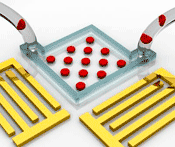Physicists in the US have unveiled a new chip-based device capable of manoeuvring tiny objects using sound. These "acoustic tweezers" could provide a simpler and more energy-efficient alternative to the more established technology of optical tweezers, say the researchers. In addition, the small size and delicate functioning of the device could eventually lead to new "lab-on-a-chip" applications in medicine and industry.

Acoustic tweezers
The acoustic tweezers exploit a phenomenon known as surface acoustic waves (SAW) – sound waves that penetrate just one wavelength into a material when propagating along its surface. The researchers have combined two SAWs in their device to generate a standing wave across a chip. When a microscopic object is placed in the standing wave, it moves along a pressure gradient until it reaches a node – that is, a point where the two waves cancel each other out – and the object comes to a complete standstill.
Trapped in a standing wave
The researchers at Pennsylvania State University, led by Jinjie Shi, fabricated their device on a piezoelectric chip. The acoustic waves are generated from transducers along the edges of the chip, which convert the tiny electric currents into pressure fluctuations. Finally, a series of microchannels filled with fluid are etched into the chip using photolithography, to lubricate the movement of particles.
To demonstrate the acoustic tweezers, the researchers arranged a series of fluorescent polystyrene beads about 1.9 µm in diameter into a grid pattern. They then carried out the same demonstration using the red blood cells of a cow and the bacteria E.Coli.
Even though the wavelength of the acoustic wave is significantly longer than that of light, the fact that nodes are single points in space makes the precision of acoustic tweezers higher, in theory, than optical tweezers. The researchers say that the new device has several other advantages over optical tweezers, which are a more established technology that uses the momentum of light to move microscopic objects. One of the main benefits for medical usage is that the acoustic tweezers can be used to manipulate living cells without inflicting any damage or killing them.
Lab on a chip
The hope is that the optical tweezers can be integrated into a single chip that can perform single or multiple functions in what is often termed a "lab-on-a-chip". "A platform based on the acoustic tweezers could make a system with specific applications such as blood analysis, cell studies and tissue engineering," Shi told physicsworld.com.
Another potential advantage is the cost and manufacture process. "The energy intensity requirement in acoustic tweezers is 500,000× lower than in optical tweezers," says Shi. "The easy fabrication and high yield also make the acoustic tweezers extremely low cost ($20 per set) in comparison to the optical tweezers (more than $100,000 per set)."
One limitation of the present design, however, is that the patterns of microscopic objects are fixed once formed. Shi says that his team is now working to overcome this problem by developing a set of tuneable tweezers using slanted transducers to generate acoustic waves.
This research will be published in an upcoming edition of Lab on a Chip.